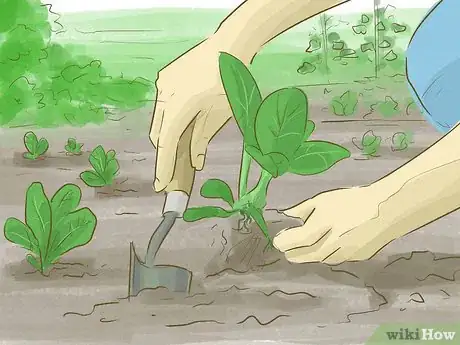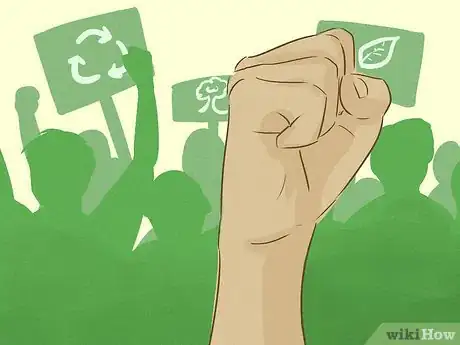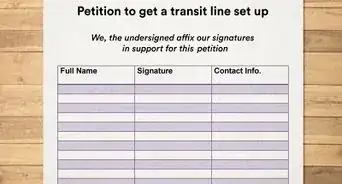This article was co-authored by wikiHow Staff. Our trained team of editors and researchers validate articles for accuracy and comprehensiveness. wikiHow's Content Management Team carefully monitors the work from our editorial staff to ensure that each article is backed by trusted research and meets our high quality standards.
There are 10 references cited in this article, which can be found at the bottom of the page.
This article has been viewed 32,465 times.
Learn more...
Illegal logging refers to any business practice in which trees are harvested or extracted without proper clearance or oversight. Though it may sound harmless, illegal logging is a leading cause of deforestation around the world, creating disruptions that can permanently destroy ecosystems.[1] Thankfully, the past 40 years have seen major advancements in the fight against illegal logging, and there are many things you can do to keep the battle going.
Steps
Making Small Changes
-
1Recycle your paper. Instead of throwing away your used paper, recycle it! Companies can turn old, donated paper into new products, producing many of the pulp-based items you need while protecting forests around the world. Most major cities offer curbside recycling services, and private recycling drop-offs are available around the world.[2]
- Shredded paper is harder to recycle, so keep your documents whole when possible.
- Soiled paper cannot be recycled, so try to keep your supplies clean.
-
2Purchase items with an FSC label. The Forest Stewardship Council is an international regulatory group that makes sure commercial foresting practices are done responsibly. To support the organization and companies that meet its standards, purchase paper and other products bearing the FSC logo whenever possible.[3]
- For small products, FSC logos are typically found on the front or back of the package in the bottom-right corner.
- For large and bulk products, FSC logos may be stamped on the side or printed on an attached tag.
Advertisement -
3Raise awareness through social media websites. Social media is a great way to spread simple messages about the dangers of illegal logging. Using Facebook, Twitter, Instagram, YouTube, and similar websites, make occasional posts revolving around the importance of forest preservation, recycled and FSC-approved products, and legislation concerning logging practices.[4]
- Try sharing articles from places like the World Wildlife Fund to lead people to professional resources.
- When the environment is in the news, try sharing a simple message of support for forest protection and regulation.
- Many people tune out those who make a lot of political comments, so avoid making all your posts about logging and conservation.
-
4Educate your friends and family. The best way to spread awareness is right from the ground floor. Let you friends and family know about the dangers of illegal logging and the things they can do to make a difference, like replacing a product they use with a better alternative. Don’t worry if they aren’t immediately responsive, just give them the information so they can think about it over time.
- If a friend throws paper away when recycling options are available, say something like “You know, recycling is free and helps out the environment.”
- If a family member buys products not approved by the FSC, show them an alternative and say “Next time, see if you can buy this. It’s just as good and helps protect forests.”
Supporting a Service Organization
-
1Find a non-profit organization that fights illegal logging practices. Look for a nature-oriented charity that lists specific information about what they do to stop illegal logging. Good national and international options include The Conservation Fund, the Natural Resources Defense Council, the World Wildlife Fund, Greenpeace, and the Sierra Club.
- To find more organizations, consult websites like Charity Navigator and the IRS Charity Database.[5]
-
2Donate to the organization. Most non-profit organizations offer one-time and recurring donation options directly through their website. Even if you can only give a small amount, remember that every penny helps. Some charitable donations are tax deductible, so keep your receipts.[6]
- Along with donations, some charities sell shirts, bags, stickers, and similar items to raise funds.
-
3Become a member of the organization. For some organizations, this means simply meeting a specific donation level. However, for others, a membership may give you access to a network of information, resources, and people interested in helping the cause. If you become invested in the organization’s other missions as well, see if they offer internships or job opportunities.[7]
- Before becoming a member, consult websites like Charity Watch to make sure the organization meets high standards.[8]
-
4Participate in organization activities. Most organizations centered around political and social activism hold events and missions that members can participate in. Look for ones related to forest preservation or illegal logging prevention and see how you can help.
- For those who want to stay local, look for assignments like cold calling potential donors and talking with local business owners.
- For those who want to travel, look for events related to working in forests or surveying landscapes.
Getting Political
-
1Make flyers, posters, and other materials to start an awareness campaign. On a local scale, small awareness campaigns can bring a lot of attention to otherwise overlooked issues. Make flyers, posters, and similar materials that you can post online, deliver door-to-door, and pass out in areas with lots of foot traffic. With permission, hang them at local colleges and businesses.[9]
- Use striking images, like falling trees or barren forests, to capture people’s attention.
- Use simple slogans, like “Save Mother Earth” or “Go Green,” to convey your message quickly.
-
2Participate in petitions, protests, and boycotts. When they receive broad support, written petitions, public protests, and product boycotts can have a strong effect on business owners and politicians. Though they may not come around often, participate when they do, and try to get your friends and family members involved.
- Local environmental organizations often keep members updated on petitions, protests, and boycotts through e-mail and social media.
-
3Call or visit your elected officials. It can be easy to forget, but members of congress, parliament, and other governing bodies care about what their constituents think. Call your officials to express concern about illegal logging and see what they’re doing to stop it. For local officials, try to ask your question at a town hall meeting, putting a face to the cause.[10]
- Though easier to deliver, letters and e-mail have a lower chance of getting your representative’s attention.
-
4Vote for politicians who support environmental causes. Often, the best way to protect nature is through laws and official government policies. Vote for politicians on the local, district, state, and national level that respect organizations like the Environmental Protection Agency and have strong stances on protecting forests and other natural habitats.
- Try participating in election campaigns for politicians you support.
- If a local position is open, try running for office to see if you can make a difference.
References
- ↑ https://www.usaid.gov/biodiversity/illegal-logging-and-deforestation
- ↑ https://archive.epa.gov/wastes/conserve/materials/paper/web/html/papermaking.html
- ↑ https://us.fsc.org/en-us/what-we-do
- ↑ https://www.oecd.org/mena/governance/Young-people-in-OG.pdf
- ↑ https://www.charitynavigator.org/index.cfm?bay=search.categories&categoryid=4
- ↑ https://dor.wa.gov/education/industry-guides/nonprofit-organizations
- ↑ https://www.mentalhealth.gov/talk/community-conversation/services
- ↑ https://www.charitywatch.org/home
- ↑ https://ctb.ku.edu/en/table-of-contents/participation/promoting-interest/posters-flyers/main











-Step-4.webp)









-Step-14-Version-6.webp)


















































